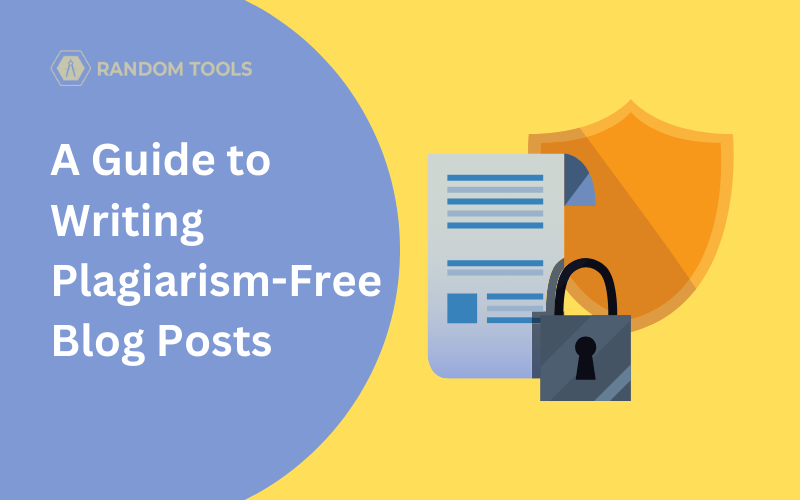The internet is the best place to acquire information regarding almost everything. Millions of blogs are published every day on the web. The abundance of information and content made it easier for users to get information and learn new things.
However, it has also established a competitive environment, creating an issue for writers. The chances of unintentional plagiarism have increased as writers don’t know whether the words or sentences they are writing are already published elsewhere. They put in more and more effort trying to evade plagiarism and presenting their work as original.
If you are also a blogger whose only desire is to make your posts plagiarism-free, you might have also been exploring ways all the time. Thankfully, some practical writing techniques and tips make blog posts 100% plagiarism-free.
Explore this guide to writing plagiarism-free blog posts to learn more about them.
Be Careful During Topic Research
Not properly carrying out research is the key reason behind a plagiarized post. Accessing a few sources limits the writers’ thoughts and understanding of the topic. They are limited to getting inspiration from those sources and fail to have unique ideas.
Before getting your hands on your keyboard, carefully perform the topic research. Conduct extensive research and consult multiple resources to know what others say. You may find other articles that either directly favor your title, contradict it, or offer an entirely neutral viewpoint.
You should gather information for your topics from various sources to have unlimited ideas to express a single matter. Don’t rush; trust the process, learn from other blog writers, and get inspiration from their unique perspectives.
Brainstorm Unique Ideas
Being a blogger is about creating unique content ideas and presenting them versatilely. Therefore, if you want to create a plagiarism-free blog post, don’t just stop at the most appealing topic or include ideas from multiple sources as it is.
Instead, use your creative skills, brainstorm, and organize your thoughts to have a unique idea. Try to vocalize your thoughts and write your opinions on the blog topic. Please don’t follow the direct approach to the subject; try to explore its different perspectives and add personal insights.
Once you’ve written down ideas and gathered all the needed data from different sources, start writing them down in your own words/style. Brainstorming unique ideas and implementing creativity ensures that your blog stands out among others, avoiding plagiarism.
Avoid Imitating Others Writing Style
An important thing to consider while writing blog posts is to avoid copying your researched articles and blogs. Close all the tabs you have opened to get ideas and focus on your plain text document while writing.
If you keep peaking them during the writing journey, you will likely accidentally imitate their writing patterns. Not only will you follow their unique writing style, but you may also include fascinating words that capture your attention.
Writing in such a manner will result in plagiarism in your blog post, and you ultimately have to face penalties. Therefore, never try to imitate other writers; develop your unique writing style. Always write your blog content in your own voice and writing pattern.
Implement Paraphrasing Techniques
Paraphrasing has always been an effective technique to avoid plagiarism. The main idea behind plagiarism is copying someone else words in your writing. While paraphrasing involves altering word usage and sentence formation to present sentences uniquely.
Therefore, by implementing paraphrasing techniques, any idea can be written versatile and plagiarism-free.
Novice bloggers who aren’t proficient in paraphrasing skills might learn to paraphrase using an online paraphraser. It can automate the paraphrasing process and guide them regarding the correct word choice according to the context.
Paraphrasing tools are designed using intelligent AI technology that completely comprehends the human written texts and their context. Then, it generates a unique and creative version of text using different synonyms and modifies sentence structure.
The paraphrased text it provides is entirely free from any plagiarism. Moreover, while paraphrasing, the paraphrase tool doesn’t compromise the readability and quality of the sentences.
Conclusion
Plagiarism can be a concern for every blogger, pushing them down on search engines and reducing their readership. Therefore, careful consideration should be made to avoid it at any cost. If you want to write a plagiarism-free blog post, follow some helpful tips as mentioned above and lead your way to more engagement by the audience.
You can expand your topic research to consult multiple sources, brainstorm ideas to have a unique one, and develop your writing style (that doesn’t reflect other writers’ styles). Furthermore, it would be best to try getting assistance from the paraphrasing tool. Using this tool, you can be confident that your blog post will be of the highest quality and free of plagiarism.

